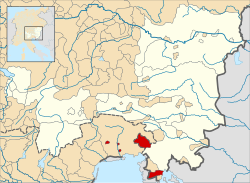County of Gorz
| (Princely) County of Gorizia | ||||||||||
|
(Gefürstete) Grafschaft Görz Contea (Principesca) di Gorizia |
||||||||||
| State of the Holy Roman Empire | ||||||||||
|
||||||||||
|
||||||||||
|
County of Gorizia (red) at the time of the Hohenstaufen Emperors (circa 1250); the highlighted area roughly corresponds with the later Austrian Circle, which is provided for context only
|
||||||||||
| Capital | ||||||||||
| Government | Principality | |||||||||
| Historical era | Middle Ages | |||||||||
| • | Meinhard, Count of Gorizia | 1127 | ||||||||
| • | Meinhard III inherited Tyrol | 1253 | ||||||||
| • | Raised to principality | 1365 | ||||||||
| • | Bequeathed to House of Habsburg | 1500 | ||||||||
| • | Joined Austrian Circle | 1512 | ||||||||
| • | Reunited with Gradisca | 1747 | ||||||||
|
||||||||||
The County of Gorizia (Italian: Contea di Gorizia, German: Grafschaft Görz, Slovene: Goriška grofija, Friulian: Contee di Gurize), from 1365 Princely County of Gorizia, was a State of the Holy Roman Empire. Originally mediate Vogts of the Patriarchs of Aquileia, the Counts of Gorizia (Meinhardiner) ruled over several fiefs in the area of Lienz and in the Friuli region of northeastern Italy with their residence at Gorizia (Görz).
In 1253 the Counts of Gorizia inherited the County of Tyrol, from 1271 onwards ruled by the Gorizia-Tyrol branch which became extinct in the male line in 1335. The younger line ruled the comital lands of Gorizia and Lienz until its extinction in 1500, whereafter the estates were finally acquired by the Austrian House of Habsburg.
Count Meinhard I, a descendant of the Meinhardiner noble family with possessions around Lienz in the Duchy of Bavaria, is mentioned as early as 1107. As a vogt official of the Patriarchs of Aquileia, he was enfeoffed with large estates in the former March of Friuli, including the town of Gorizia, and from 1127 on called himself a Graf von Görz.
...
Wikipedia



